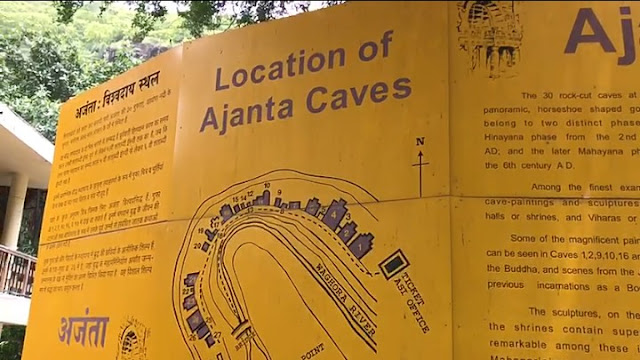'World Heritage Site Special'
These are photographs of English commemoratives board, exterior and interior of thousands years old Ajanta Caves Monuments located at Ajanta, Aurangabad District , Maharashtra, India. 30 rock-cut Buddhist caves Monuments, dated back from 2nd century B. C. to 1st century A. D. And 5th century A. D to 6th century A. D. at Ajanta have been excavated in a panoramic, horseshoe shaped gorge of the Waghora River. This site is a proof of civilized civilization of ancient man of Sub-continent. Ancient Paintings and rock-cut sculptures of Ajanta Caves Monuments are Exemplary and well preserved by the authorities. These caves are masterpieces of Buddhist religious art. Ajanta Caves Monuments is a protected Monument and have been a UNESCO World Heritage Site since 1983.
The History of Ajanta caves written on commemorative board Erected by World Heritage Site Organization describes as under:
'Ajanta'
'30 rock-cut caves at Ajanta have been excavated in a panoramic, horseshoe shaped gorge of the Waghora River. They belong to two distinct phases of Buddhism, the earlier Hinayana phase from the 2nd century B. C to 1st century A. D. And later Mahayana phase from the 5th century A. D to 6th century A. D.
Among the finest examples of Buddhist architecture, cave-paintings and Sculptures, these caves comprise Chaitya halls or shrines, and Viharas or monasteries
Some of the magnificent paintings, for which Ajanta is World-famous can be seen in caves 1,2,9, 10,16 and 17. They depict episodes from the life of the Buddha and seen from the Jataka which relate to Buddha 's previous incoronation as Budhissattva.
The sculptures on the facade of some of the caves and in the Shrines contain superb images of Buddha. More remarkable among these is the one Depicting the Buddha' s Mahaparinirvana, - his ultimate release from the cycle of rebirth. In cave 26, evoking a sense of awe and reverence.'
Photographs By Dr. Dalvir Pannu Sahib
These are photographs of English commemoratives board, exterior and interior of thousands years old Ajanta Caves Monuments located at Ajanta, Aurangabad District , Maharashtra, India. 30 rock-cut Buddhist caves Monuments, dated back from 2nd century B. C. to 1st century A. D. And 5th century A. D to 6th century A. D. at Ajanta have been excavated in a panoramic, horseshoe shaped gorge of the Waghora River. This site is a proof of civilized civilization of ancient man of Sub-continent. Ancient Paintings and rock-cut sculptures of Ajanta Caves Monuments are Exemplary and well preserved by the authorities. These caves are masterpieces of Buddhist religious art. Ajanta Caves Monuments is a protected Monument and have been a UNESCO World Heritage Site since 1983.
The History of Ajanta caves written on commemorative board Erected by World Heritage Site Organization describes as under:
'Ajanta'
'30 rock-cut caves at Ajanta have been excavated in a panoramic, horseshoe shaped gorge of the Waghora River. They belong to two distinct phases of Buddhism, the earlier Hinayana phase from the 2nd century B. C to 1st century A. D. And later Mahayana phase from the 5th century A. D to 6th century A. D.
Among the finest examples of Buddhist architecture, cave-paintings and Sculptures, these caves comprise Chaitya halls or shrines, and Viharas or monasteries
Some of the magnificent paintings, for which Ajanta is World-famous can be seen in caves 1,2,9, 10,16 and 17. They depict episodes from the life of the Buddha and seen from the Jataka which relate to Buddha 's previous incoronation as Budhissattva.
The sculptures on the facade of some of the caves and in the Shrines contain superb images of Buddha. More remarkable among these is the one Depicting the Buddha' s Mahaparinirvana, - his ultimate release from the cycle of rebirth. In cave 26, evoking a sense of awe and reverence.'
Photographs By Dr. Dalvir Pannu Sahib



































No comments:
Post a Comment